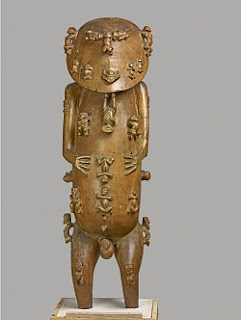The sculpture of A'a in the British Museum was probably originally carved to serve as a reliquary for the bones of A’a Carbon dating of the most important surviving Polynesian wooden sculpture has revealed that it is older than once thought (Martin Bailey Polynesian sculpture admired by Picasso and Henry Moore far older than previously thought The Art Newspaper 15th August 2016)
 |
| Sculpture of A’a (Image: © The Trustees of the British Museum) |
The British Museum’s Polynesian sculpture of A’a is much older than previously thought. [...] it is probable that the tree from which it was carved was felled in around 1505. This would make A’a the earliest dated wooden sculpture from Polynesia. Named after a key god of the island of Rurutu, the sculpture is a carved man-like figure 1.2m tall. Thirty small figures emerge out of his skin. His feet are missing, probably because they rotted away at some point. The penis, which was once erect, has been broken off, perhaps by Christian missionaries. [...] Some of Rurutu’s chiefs had converted to Christianity, and to demonstrate their new allegiance they sent a boat with pagan idols to the island of Ra’iatea, 560km to the north, where the London Missionary Society had set up a base. [...] A’a was saved and sent to Britain, where it was displayed in the London Missionary Society’s museum. In 1890 the society lent A’a to the British Museum and ownership was transferred in 1911.This is a fluff piece intended to show the benefits of having things like this in a London Museum. Furthermore western culture can lay a claim on it:
A’a has long been admired by Western artists. Henry Moore was first struck by the sculpture when he saw it in the 1920s. For his 80th birthday, in 1978, the British Museum presented him with a cast. From this, he commissioned a bronze copy, which he kept in the entrance hall to his Hertfordshire home, Hoglands, where it remains on view. In 1950 Picasso saw a cast of A’a on a visit to the studio of the English surrealist, Roland Penrose. Picasso was so enchanted that he arranged to have a bronze cast. This stood prominently in his studio in the Villa La Californie in Cannes, close to his easel.Which I guess makes it OK to have the coffin of somebody else's "key god" in your gallery of trophy art.
No comments:
Post a Comment